
Constitución railway station is a large railway station in Constitución, a barrio in central Buenos Aires, Argentina. The full official name of the station is Estación Plaza Constitution reflecting the fact that the station is located opposite Constitution Square, two kilometers to the south of the Obelisco landmark. The ground floor of the station has fourteen tracks and the floor below has two tracks for the Buenos Aires Underground.

Once railway station is a large railway terminus in central Buenos Aires, Argentina, in the barrio of Balvanera.
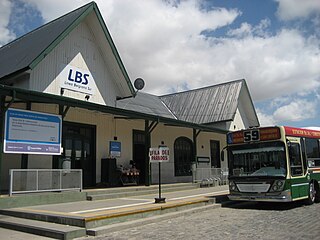
Buenos Aires is a former passenger railway station in the city of Buenos Aires, Argentina. The station was terminus of the Belgrano Sur line that runs trains along Greater Buenos Aires region.

Federico Lacroze railway station is a passenger railway station in Buenos Aires, Argentina. The station is located in the city's outlying barrio (neighbourhood) of Chacarita in a predominantly residential area. It is just a short distance north of the Cementerio de la Chacarita, the city's largest cemetery. The station is named after Federico Lacroze, a prominent 19th century Argentine railway and transport pioneer who obtained the concession for building the Buenos Aires Central Railway in 1884. When the Argentine railway network was nationalised in 1948 the station became the Buenos Aires terminus for the lines that became part of the General Urquiza Railway (FCGU).

Flores is a middle-class barrio or district in the center part of Buenos Aires city, Argentina. Flores was considered a rural area of the Province of Buenos Aires until 1888 when it was integrated into the city. Flores is the birthplace of Pope Francis.

The Domingo Faustino Sarmiento Railway (FCDFS), named after the former Argentine president, statesman, educator, and author Domingo Faustino Sarmiento, is one of the six state-owned Argentine railway divisions formed after President Juan Perón's nationalisation of the Argentine railway network in 1948. The six companies were managed by Ferrocarriles Argentinos which was later broken up during the process of railway privatisation beginning in 1991 during Carlos Menem's presidency.

The Sarmiento line is a broad gauge commuter rail service in Buenos Aires Province, Argentina, run by the state-owned Trenes Argentinos since 11 September 2013.

The Belgrano Sur line is an Argentine 1,000 mmmetre gauge commuter rail service in the Greater Buenos Aires area, currently operated by state-owned enterprise Trenes Argentinos. The Belgrano Sur runs over tracks and through stations built by the Franco–Belgian-owned Compañía General de Buenos Aires and British Midland companies at the beginning of the 20th century.
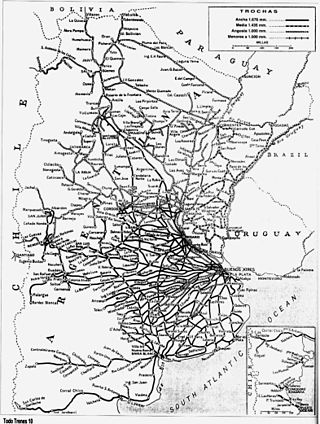
The Argentine railway network consisted of a 47,000 km (29,204 mi) network at the end of the Second World War and was, in its time, one of the most extensive and prosperous in the world. However, with the increase in highway construction, there followed a sharp decline in railway profitability, leading to the break-up in 1993 of Ferrocarriles Argentinos (FA), the state railroad corporation. During the period following privatisation, private and provincial railway companies were created and resurrected some of the major passenger routes that FA once operated.
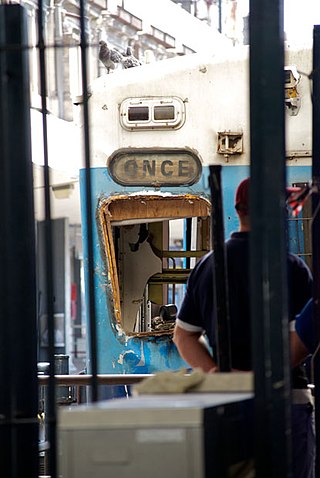
The 2012 Buenos Aires rail disaster, also known as the Once Tragedy, occurred on 22 February 2012, when a train crashed at Once Station in the Balvanera neighbourhood of Buenos Aires, Argentina.

The Brandsen rail disaster occurred on March 8, 1981, in Brandsen, a town in Buenos Aires Province in Argentina, when a passenger train carrying 803 passengers collided head-on with a freight train, killing 34 and injuring another 74. The train crash was caused by points failure.
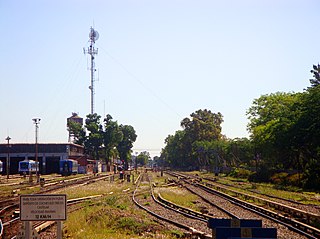
The 2013 Castelar rail disaster occurred on 13 June 2013 at about 07:30 local time, in the Castelar neigborhood of Morón Partido in Greater Buenos Aires area, about 30km west of the city of Buenos Aires, Argentina.
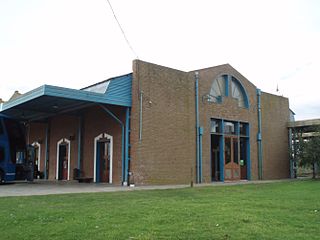
Chascomús is a railway station and bus terminus in the homonymous city of Buenos Aires Province, Argentina. Construction began on his station in 1983 when Raúl Alfonsín was President of Argentina but works were interrupted and finally cancelled until they were resumed in 2014 and the station was finished and opened to public on December 19. Station's facilities and services include railway platforms, bus garages, accessible toilets and a coffeehouse.

Mar del Plata is a railway and bus terminus in the homonymous city of Buenos Aires Province, Argentina. Opened in 2009 as a bus terminus only, the railway tracks from the old "Norte" station were extended to connect both terminals in 2011 by architect Claudio Luis Lucarelli, adding new platforms to receive trains from Buenos Aires.

The Tren de los Pueblos Libres was an 813-km length rural railway line that connected Argentina and Uruguay, being operated by both the Argentine private company Trenes de Buenos Aires (TBA) on General Urquiza Railway standard gauge rail tracks, and Uruguayan the State-owned State Railways Administration of Uruguay "Administración de Ferrocarriles del Estado" (AFE).

Retiro-Mitre, or simply Retiro, is one of the six large mainline railway station termini in Buenos Aires, Argentina. Located in the neighborhood of Retiro, it serves as terminal station for the Mitre Line that runs local trains to the northern suburbs of the Buenos Aires metropolitan area. It also functions as terminal station for the national General Mitre Railway.
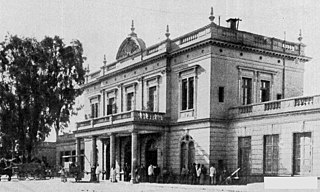
Santa Fe is a railway station located in the city of Santa Fe, Argentina in the province of the same name, Argentina. The station is no longer used for railway services since 2007, when defunct company Trenes de Buenos Aires cancelled its services to Santa Fe.

The CSR EMU is a series of electric multiple unit cars manufactured by CSR Corporation Limited for use on Buenos Aires' commuter rail network. As of 2015, the trains operated on three of the city's lines and 705 cars were manufactured, with each line using a different number of cars per train. They were created for use on lines electrified using both third rail and overhead lines.

Provincial Route 63 is a 29-kilometre-long (18 mi) Argentine road in the East of Buenos Aires Province. The road extends from Dolores, Buenos Aires to the "Esquina de Crotto", a paraje in Tordillo Partido.



















